
Jan Brueghel the Elder stands as a pivotal figure in Flemish art, bridging the late Renaissance and the burgeoning Baroque period. Active during the late 16th and early 17th centuries, he carved a unique niche for himself, distinct from his famous father, yet deeply rooted in the artistic traditions of the Low Countries. Renowned for his exquisite detail, vibrant colours, and mastery across various genres, he earned affectionate nicknames like "Velvet Brueghel," "Flower Brueghel," and "Paradise Brueghel," each hinting at the specific brilliance found within his diverse body of work. His life and art offer a fascinating window into the cultural richness and artistic innovation of Antwerp's Golden Age.
Early Life and Artistic Formation
Born in Brussels in 1568, Jan Brueghel the Elder entered a world already steeped in artistic legacy. He was the second son of the legendary Pieter Bruegel the Elder, one of the most significant painters of the Northern Renaissance, celebrated for his peasant scenes and panoramic landscapes. However, Jan barely knew his father, who passed away when he was just a year old, in 1569. His artistic upbringing was therefore shaped by other members of his talented family.
Following his father's death, Jan's maternal grandmother, Mayken Verhulst, took charge of his early artistic education. Verhulst was herself an accomplished miniaturist and watercolourist, and it is widely believed that she imparted her meticulous techniques and appreciation for detail to her young grandson. This foundational training in watercolour likely contributed to the delicate precision that would later characterize his oil paintings.
Further formal training came under the tutelage of Pieter Goetkint, a significant Antwerp art dealer and painter with a well-stocked collection. This apprenticeship exposed the young Brueghel to a wider range of artistic styles and likely provided him with practical knowledge of the art market. Growing up surrounded by artists and art, Jan Brueghel the Elder was immersed in a creative environment that nurtured his innate talent and set the stage for his future success.
The Italian Journey and Return to Antwerp
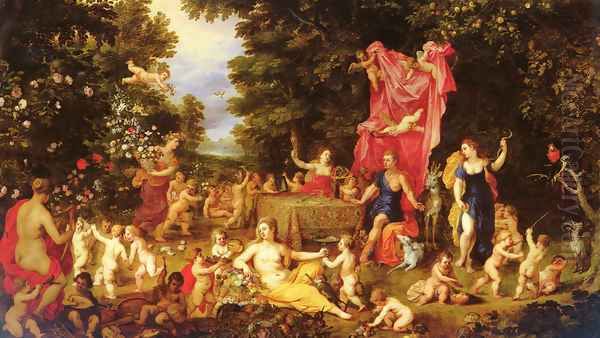
Like many ambitious Northern European artists of his time, Jan Brueghel the Elder embarked on a transformative journey to Italy around 1589. This period abroad was crucial for his artistic development, exposing him to the masterpieces of the Italian Renaissance and the burgeoning trends of the early Baroque. He travelled extensively, spending significant time in Naples, Rome, and Milan between approximately 1592 and 1595.
In Rome, he moved within circles of Northern artists and established important connections. His talent attracted the attention of influential patrons, most notably Cardinal Federigo Borromeo in Milan. Borromeo became a lifelong friend and avid collector of Brueghel's work, commissioning numerous paintings and offering crucial support. This patronage not only provided financial stability but also intellectual stimulus, as Borromeo was a leading figure of the Catholic Counter-Reformation and a man of refined artistic taste.
During his Italian sojourn, Brueghel absorbed the lessons of Italian art, particularly its approach to composition, light, and the idealization of form. However, he did not simply imitate Italian models. Instead, he synthesized these influences with his Northern heritage, developing a unique style characterized by meticulous detail, luminous colour, and a profound sensitivity to the natural world. His experiences in Italy refined his skills and broadened his artistic horizons, particularly impacting his landscape and still life painting.
Around 1596, Jan Brueghel the Elder returned to the Southern Netherlands and settled in Antwerp, the bustling artistic and commercial hub of the region. He quickly established himself, becoming a master in the prestigious Guild of Saint Luke in 1597. His reputation grew rapidly, and in 1602, he was elected dean of the Guild, a testament to his standing among his peers. Antwerp would remain his home base for the rest of his productive career.
Artistic Style: The "Velvet" Touch
Jan Brueghel the Elder's distinctive style earned him the moniker "Velvet Brueghel." This nickname perfectly encapsulates the defining qualities of his art: an incredibly refined technique, a smooth, almost enamel-like finish, and a rich, jewel-toned palette. His brushwork is exceptionally fine, allowing him to render minute details with astonishing precision, whether depicting the delicate petals of a flower, the intricate patterns on an insect's wing, or the textures of various fabrics and objects.
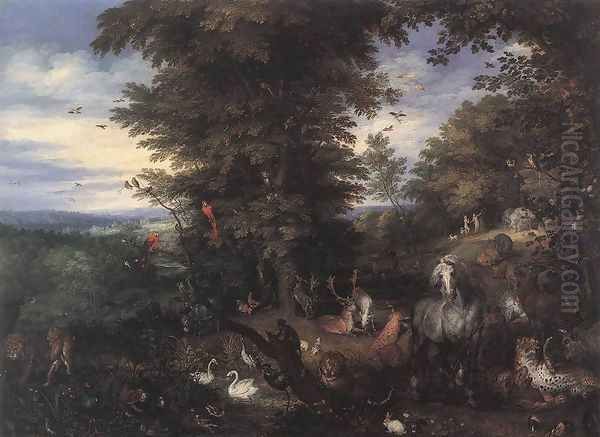
His paintings possess a luminous quality, achieved through the careful application of thin glazes of oil paint, often on copper panels, which enhanced the brilliance and depth of the colours. Unlike the broader, more painterly approach of some contemporaries, Brueghel's surfaces are typically smooth and highly finished, inviting close inspection. This meticulousness lends his works an air of preciousness and luxury.
Beyond the technical finesse, Brueghel's style is marked by a deep engagement with the natural world. His landscapes and still lifes are based on careful observation, reflecting the growing scientific curiosity of the age. He possessed an almost encyclopedic knowledge of flora and fauna, depicting species with remarkable accuracy. Yet, his naturalism is tempered with an element of idealization, creating harmonious compositions that often feel like miniature, perfectly ordered worlds.
His use of colour is sophisticated and vibrant. He employed expensive pigments like lapis lazuli to achieve brilliant blues and carmine for deep reds, contributing to the luxurious feel of his paintings. Light plays a crucial role, often rendered softly and diffusely, unifying the composition and enhancing the sense of atmosphere, whether in a sunlit forest clearing or an opulent interior scene.
Master of Diverse Genres
Jan Brueghel the Elder demonstrated remarkable versatility, excelling across an unusually wide range of genres. While perhaps best known for his floral still lifes and landscapes, his oeuvre also includes mythological scenes, allegorical paintings, religious subjects, and even depictions of village life and markets, echoing themes explored by his father but rendered in his own distinct, refined style.
Landscapes
Building upon the tradition established by his father, Pieter Bruegel the Elder, Jan developed landscape painting in new directions. While his father often focused on panoramic views with a high viewpoint, Jan favoured lower viewpoints and more intimate scenes, often depicting wooded landscapes, river views, and village settings. His landscapes are rarely empty stages; they are typically populated with small figures engaged in various activities – travellers, peasants, mythological beings, or biblical characters – adding narrative interest and enlivening the scene. Works like River Landscape (1607) showcase his ability to create atmospheric depth and capture the subtle effects of light on water and foliage. He often used horizontal and diagonal compositional structures to lead the viewer's eye through the scene.
Floral Still Lifes
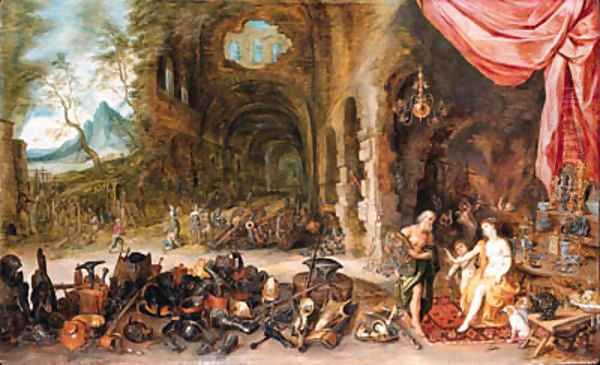
Jan Brueghel the Elder is considered one of the pioneers, if not the inventor, of the independent floral bouquet still life as a distinct genre. These paintings, often executed on copper for maximum luminosity, are celebrated for their exquisite detail, vibrant colours, and botanical accuracy. Brueghel depicted a wide variety of flowers, often combining blooms from different seasons into a single, impossibly perfect arrangement. These bouquets were not merely decorative; they were luxury items, showcasing rare and exotic flowers cultivated in the gardens of the wealthy, and often carried symbolic meanings related to transience (vanitas) or divine creation. His meticulous rendering captured the unique texture and form of each flower, making these works marvels of observation and technical skill.
Allegorical and Mythological Scenes
Brueghel frequently collaborated with other artists, most notably Peter Paul Rubens, on allegorical and mythological paintings. In these collaborations, Brueghel typically painted the detailed settings – landscapes, animals, flowers, and still life elements – while his collaborator focused on the larger human figures. The famous series The Allegory of the Five Senses, created with Rubens, exemplifies this partnership, with Brueghel creating incredibly detailed environments filled with objects representing sight, hearing, smell, taste, and touch. The Garden of Eden, another collaboration with Rubens, showcases Brueghel's ability to depict a paradise teeming with meticulously rendered animals and plants. These works often reflected the intellectual and religious currents of the time, including Counter-Reformation ideals.
Religious Works
Religious themes also formed a significant part of Brueghel's output. He painted numerous biblical scenes, often set within elaborate landscapes or interiors. The Entry of the Animals into Noah’s Ark is a prime example, allowing him to display his mastery in depicting a vast array of animals with remarkable detail and accuracy, set against a lush landscape backdrop. Mountainous Landscape with Pilgrims in a Cave Church (or similar titles referring to pilgrims) combines his skill in landscape with a devotional subject, creating a scene that is both geographically specific and spiritually resonant. These works were popular among patrons seeking devotional images rendered with exquisite craftsmanship.
Other Scenes
Brueghel also painted market scenes, such as The Fishmonger's Market, which demonstrate his ability to capture the bustle of daily life with intricate detail and lively characterization. While perhaps less common than his landscapes or still lifes, these works show his connection to the broader traditions of Flemish genre painting inherited from his father's generation, albeit translated into his own refined and detailed idiom.
Collaboration with Rubens and Others
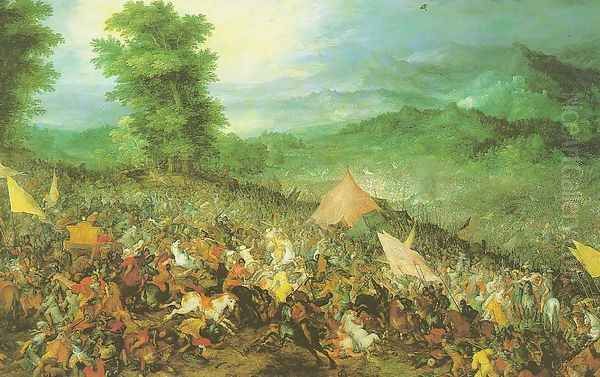
Collaboration was a common practice in the busy workshops of 17th-century Antwerp, and Jan Brueghel the Elder was a frequent and sought-after collaborator. His most famous and fruitful partnership was with his close friend, Peter Paul Rubens. Their collaboration began around 1598 and lasted until Brueghel's death in 1625, resulting in approximately 25 known works. This partnership brought together two of the leading artistic personalities of the era, combining Brueghel's meticulous detail and landscape prowess with Rubens's dynamic figures and compositional energy.
In their joint works, the division of labour was typically clear: Brueghel executed the landscapes, animals, flowers, and still-life elements with his characteristic precision, while Rubens painted the larger human figures. Masterpieces such as The Garden of Eden, The Allegory of the Five Senses series, and mythological scenes like The Feast of Achelous or Venus at the Forge of Vulcan exemplify the stunning results of their combined talents. Their collaboration was not merely technical but often conceptual, blending their distinct skills into a harmonious whole that appealed greatly to collectors.
Beyond Rubens, Brueghel collaborated with several other notable artists. He worked with the German painter Hans Rottenhammer, whom he had befriended during his time in Italy, on paintings featuring mythological or religious figures in landscape settings. He also partnered with figure specialists like Hendrick van Balen, creating numerous works where Van Balen painted the figures within Brueghel's detailed landscapes or interiors. Other collaborators included Sebastiaen Vrancx, known for his battle scenes and genre paintings. These collaborations highlight Brueghel's central position in the Antwerp art scene and his ability to work effectively with artists specializing in different areas.
Patronage and Status
Jan Brueghel the Elder enjoyed considerable success and recognition during his lifetime, attracting patronage from the highest levels of society. His early connection with Cardinal Federigo Borromeo in Milan proved enduring; the Cardinal remained a loyal patron and correspondent, commissioning numerous works that are still housed in the Biblioteca Ambrosiana in Milan today. Borromeo deeply admired Brueghel's ability to capture the beauty of God's creation in minute detail.

Upon his return to Antwerp, Brueghel's reputation quickly grew. His exquisite craftsmanship and the sheer beauty of his paintings appealed to wealthy merchants, nobles, and fellow artists. His status was further cemented by his appointment, along with Rubens, as court painter to the Archdukes Albert VII and Isabella Clara Eugenia, the Habsburg governors of the Spanish Netherlands, residing in Brussels. This prestigious position brought regular commissions and access to the court's elite circles. Works depicting the Archdukes' estates or activities, sometimes referred to in titles like The Country Excursion of Princess Elizabeth Isabella of Parma, likely stem from this court connection.
Despite his court appointment, Brueghel maintained a thriving workshop in Antwerp, catering to a broad clientele through private commissions and sales via dealers. His leadership role within the Guild of Saint Luke, serving as its dean, also underscored his professional standing and influence within the artistic community. His success allowed him to live comfortably and support a large family.
The Brueghel Dynasty
Jan Brueghel the Elder was a key figure in one of the most remarkable artistic dynasties in European history. He was the son of Pieter Bruegel the Elder, whose innovative approach to landscape and genre painting had already secured the family's fame. Jan and his older brother, Pieter Brueghel the Younger (often called "Hell Brueghel," though primarily known for copying their father's work), carried the family name forward into the next generation.
While Pieter the Younger largely replicated his father's popular compositions, Jan the Elder forged his own distinct artistic path, developing the detailed, colourful style that earned him the "Velvet" nickname. He, in turn, passed on the artistic tradition to his own son, Jan Brueghel the Younger (1601–1678). Jan the Younger trained with his father and took over the workshop after his father's death in 1625. He continued to paint in a style very similar to his father's, often producing variations of his father's successful compositions, and also engaged in collaborations.
The Brueghel dynasty extended further through marriages and apprenticeships, connecting them to other major Flemish artists like David Teniers the Younger, who married Jan Brueghel the Elder's daughter Anna. This network of family ties and artistic exchange helped shape the course of Flemish painting for several generations, with Jan Brueghel the Elder playing a crucial role as both inheritor and innovator within this powerful artistic lineage.
Later Life and Legacy
Jan Brueghel the Elder remained highly productive throughout his career. His workshop in Antwerp was prolific, producing a large number of high-quality paintings that were in great demand across Europe. He maintained his connections with patrons like Cardinal Borromeo and the Archdukes Albert and Isabella, while also continuing his successful collaborations, particularly with Rubens.
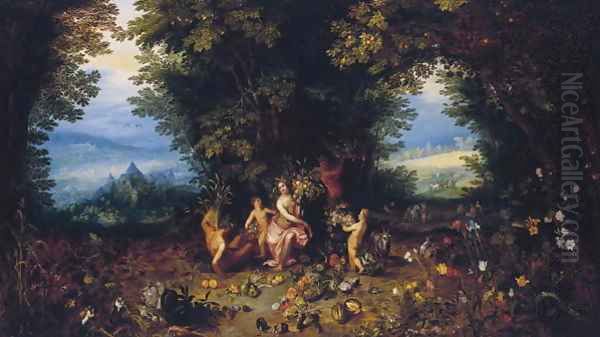
Tragically, Jan Brueghel the Elder's life was cut short during a cholera epidemic that swept through Antwerp in 1625. He succumbed to the disease, reportedly along with three of his younger children, Paschasia, Maria, and Ambrosius. He was 57 years old at the time of his death. His passing was a significant loss to the art world, leaving behind a rich legacy and an active workshop that would be continued by his son, Jan Brueghel the Younger.
The influence of Jan Brueghel the Elder extended far beyond his own lifetime. His innovations in landscape and, particularly, floral still life painting had a profound impact on subsequent generations of artists in both Flanders and the Dutch Republic. Artists like his son Jan the Younger, his son-in-law David Teniers the Younger, and still life specialists such as Frans Snyders and Daniel Seghers drew inspiration from his meticulous technique, vibrant colours, and detailed observation of nature. His collaborative model, especially with Rubens, also set a precedent for workshop practices.
Today, Jan Brueghel the Elder is recognized as one of the most important painters of the Flemish Baroque. His works are prized possessions in major museums worldwide, including the Louvre in Paris, the Prado Museum in Madrid, the Kunsthistorisches Museum in Vienna, the National Gallery in London, and the Getty Museum in Los Angeles, among many others. His paintings continue to captivate viewers with their intricate beauty, technical brilliance, and detailed depictions of the natural and man-made world of the early 17th century.
Conclusion
Jan Brueghel the Elder occupies a unique and significant place in the history of art. As the inheritor of a famous name, he successfully navigated the legacy of his father, Pieter Bruegel the Elder, by forging his own distinct artistic identity. His "Velvet" style, characterized by meticulous detail, luminous colour, and a refined finish, set him apart. He excelled across multiple genres, making pioneering contributions to landscape and floral still life painting, while also creating masterful allegorical, mythological, and religious works.
His collaborations, especially the celebrated partnership with Peter Paul Rubens, highlight his central role in the vibrant Antwerp art scene and produced some of the era's most iconic images. Patronized by cardinals and archdukes, and respected by his peers, Brueghel achieved remarkable success during his lifetime. His influence resonated through the Brueghel dynasty and inspired countless artists who followed, ensuring his enduring legacy as a master of the Flemish Baroque whose intricate worlds continue to fascinate and delight centuries later.